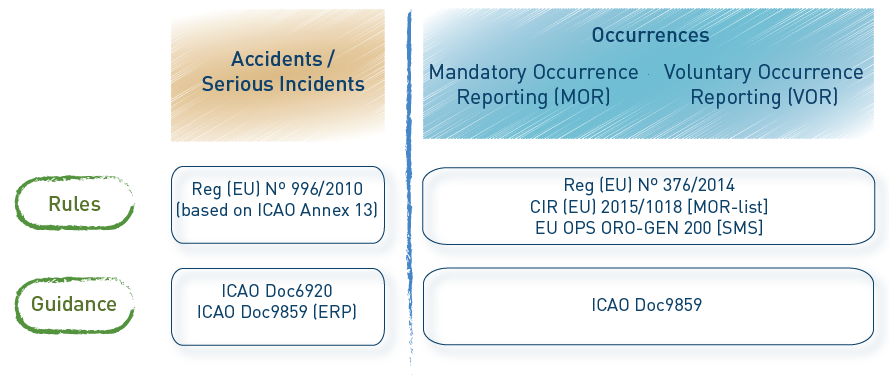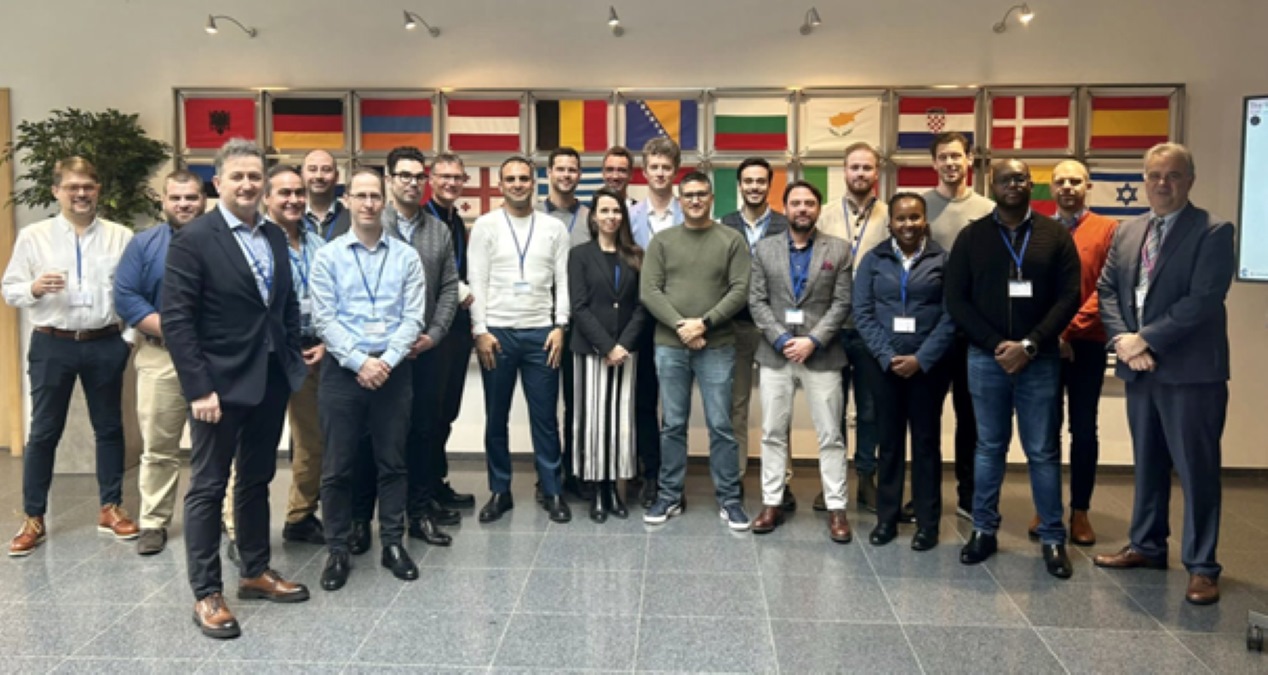
Archives
A closer look at EU 376/2014

Inside the New Occurrence Reporting Regulation
by Rudy Pont, BeCA Air Safety Committee Chairman
Legal framework
On 15 November 2015, the new regulation EU 376/2014 on the reporting, analysis and follow-up of occurrences in civil aviation came into force, replacing EC 2003/42 directive and (for Belgium) the Royal Decree 2005-1263 of 22 April 2005.
Because this text is a regulation, it has immediate effect and there is no need for a Royal Decree to convert it to Belgian national law.
This new regulation only covers occurrences. Accidents and incidents fall under EU 996/2010. The table below explains the current European legislative structure.
Objective & Scope
The new EU law basically lays down the requirements for active safety management: reporting (voluntary/mandatory), analysis and actions taken. It outlines the oversight framework, sets deadlines and has a strong emphasis on confidentiality and reporter protection under Just Culture principles. The text clearly states that the sole objective of occurrence reporting lies in the prevention of accidents and incidents and not in the attribution of blame or liability. The new rules promote data sharing at EU and national levels.
| Art. 3 – This Regulation lays down rules on: (a) the reporting of safety-relevant occurrences (b) analysis and follow-up action in respect of reported and other safety information (c) the protection of aviation professionals (d) appropriate use of collected safety information (e) the integration of information into the European safety occurrence database (European Central Repository) (f) the dissemination of anonymised information to interested parties |
New Definitions
Most definitions are based on existing ICAO material such as Annex 13 and ICAO Doc9859, but there are some new ones:
| Art. 2 ‘Occurrence’ means any safety-related event which endangers or which, if not corrected or addressed, could endanger an aircraft, its occupants or any other person and includes in particular an accident or serious incident; ‘Hazard’ means a situation or an object with the potential to cause death or injury to a person, damage to equipment or a structure, loss of material, or a reduction of ability to perform a prescribed function; ‘Just culture’ means a culture in which front-line operators or other persons are not punished for actions, omissions or decisions taken by them that are commensurate with their experience and training, but in which gross negligence, wilful violations and destructive acts are not tolerated; |
Voluntary Occurrence Reporting (VOR): tools, protection & feedback
All people involved in civil aviation may witness events which are relevant to accident prevention. Therefore everyone should be able to report such events and organisations should therefore provide their employees with appropriate reporting tools/systems.
Obviously, the reporter’s protection should be guaranteed. Occurrence reports should be disidentified and a ‘Just Culture’ should encourage individuals to report safety-related information. In this context, employees and contracted personnel should not be subject to any prejudice on the basis of information provided, except in cases of wilful misconduct or deliberate act.
In order to encourage staff to report occurrences, they should be regularly informed about actions taken (feedback).
Mandatory Occurrence Reporting (MOR): more reporters, larger list of events to be reported
Besides the voluntary reporting, the new regulation also revises the existing mandatory occurrence reporting (MOR). The regulation extends this requirement to mechanics, manufacturers, NAA staff, airport safety management personnel, ANSP maintenance staff and ground handlers.
According to the regulation Art. 4 (7), ‘the persons listed shall report occurrences within 72 hours of becoming aware of the occurrence, unless exceptional circumstances prevent this.’
| Art.4 (6) – The following persons shall report occurrences a) the pilot in command, or, in cases where the pilot in command is unable to report the occurrence, any other crew member next in the chain of command b) a person engaged in designing, manufacturing, continuous airworthiness monitoring, maintaining or modifying an aircraft, or any equipment or part thereof c) a person who signs an airworthiness review certificate, or a release to service in respect of an aircraft or any equipment or part thereof; d) a person who performs a function which requires him or her to be authorised by a Member State as a staff member of an air traffic service provider entrusted with responsibilities related to air navigation services or as a flight information service officer; e) a person who performs a function connected with the safety management of an airport; f) a person who performs a function connected with the installation, modification, maintenance, repair, overhaul, flight-checking or inspection of air navigation facilities; g) a person who performs a function connected with the ground handling of aircraft, including fuelling, loadsheet preparation, loading, de-icing and towing at an airport. |
Because there are more reporter types, the MOR-list – published in implementing regulation (EU) 2015/1018 – has also been expanded. Some examples are:
- Occurrences related to the operation of the aircraft (Annex I) (e.g. use of incorrect data, actual or potential taxiway or runway incursion, level bust, etc.)
- Occurrences related to technical conditions, maintenance and repair of aircraft (Annex II) (e.g. structural defects, system malfunction, wrong assessment of a serious defect, etc.)
- Occurrences related to air navigation services and facilities (Annex III) (e.g. collisions, near collisions or potential for collisions, ACAS RAs, Aircraft deviation from ATC clearance, etc.)
- Occurrence analysis and follow-up
So what happens with your reports? As is already the case in most airlines, each organisation must develop a process to analyse occurrences in order to identify the safety hazards. Based on that analysis, each organisation determines appropriate corrective or preventive actions.
In other words, every report should be analysed, classified and risk assessed (Art. 13). When, following the analysis, an organisation identifies any appropriate corrective or preventive action, it shall:
a) implement that action in a timely manner; and
b) monitor the implementation and effectiveness of the action.
Confidentiality & Protection of the information source
| Art. 15(2) Member States, EASA and organisations shall not make available or use the information on occurrences: (a) in order to attribute blame or liability; or (b) for any purpose other than the maintenance or improvement of aviation safety. |
| Art. 16 (2) Disidentified information shall be disseminated within the organisation as appropriate. |
Organisations must ensure that personal details are only shared internally where absolutely necessary in order to investigate the occurrence. This means that, unless critical for the investigation, the reporter name must be removed from any internal message.
Employees and contracted personnel who report or are mentioned in occurrence reports shall not be subject to any prejudice by their employer or by the organisation for which the services are provided on the basis of the information supplied by the reporter.
But there is a catch!
| Art. 16 (10) The protection shall not apply to any of the following situations: (a) in cases of wilful misconduct; (b) where there has been a manifest, severe and serious disregard of an obvious risk and profound failure of professional responsibility to take such care as is evidently required in the circumstances, causing foreseeable damage to a person or property, or which seriously compromises the level of aviation safety. |
Other frequently used terms are ‘intentional violation’, ‘sabotage’, ‘negligence’. Unfortunately, the text does not define clearly what mistakes/violations fall under this paragraph. Why? Because every case is and will be different. There are simply too many factors that come into play. And although the Regulation provides for a body of appeal (Art. 16) and even penalties (Art. 21) for organisations not adhering to Just Culture principles, the text does not specify who will actually decide between a no-blame human error or an act of wilful misconduct/serious disregard. If you want to know more about this big grey area, you can read our article on event reviews board on page 22.
One thing is for sure, because of the phrase ‘without prejudice to national criminal law’ and in the unlikely event of a criminal court case, it will be up to the judiciary to decide. This is exactly reason why a cooperation with them (‘advance arrangements’) is essential to ensure Just Culture is applied (read our full article on this aspect below).


